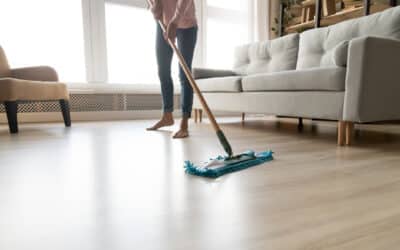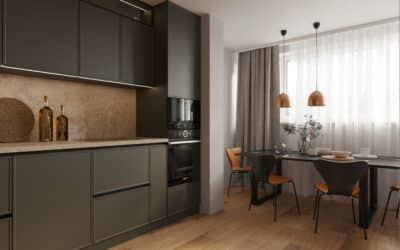Engineered hardwood is strong, durable, and long-lasting.
The wear layer, also called the top layer, is always made of real wood. The core layers are manufactured using multiple layers of wood, lumber, or composite.
Any wear layer is suitable for the home and, despite common belief, the thickness doesn’t impact the strength or durability of the floor.
What’s more important for ensuring the durability of engineered hardwood is the finish. A hardier finish should be chosen for rooms with high traffic to ensure the natural color lasts as long as possible.
Keep reading to discover what wear layer is, why it’s important, and how thick the wear layer should be on engineered hardwood for each room it’s installed within.
How Thick Should the Wear Layer Be On Engineered Wood?
Engineered hardwood has a wear layer that typically ranges from 1mm to 4mm. It’s commonly believed that the wear layer determines how long the floor will last. But the wear layer actually refers to how thick the top layer of wood in each plank is.
Therefore, a thicker wear layer doesn’t necessarily mean the flooring is more durable. It determines the number of times the floor can be resanded and refinished in the future. You won’t be able to sand and refinish engineered hardwood with a thin wear layer because there won’t be enough remaining wood.
However, most prefinished engineered hardwood has an aluminum oxide finish that will last the lifetime of the floor. Over time, you can usually apply a maintenance coat rather than completely stripping the floor to be restained. Resanding hardwood also removes the natural grain and creates a smooth finish, which often isn’t desirable.
If you plan on resanding engineered hardwood in the future, a wear layer between 3-4mm+ is recommended. But a thicker wear layer isn’t essential for ensuring you have a strong floor. It’s more important to choose a style of floor that suits your preferences, regardless of the wear layer.
Room By Room: Recommended Engineered Hardwood
Explore which type of engineered hardwood suits each room of the home best.
Living & Dining Areas

We recommend Kahrs Engineered Hardwood and Mullican.
Lounges, living rooms, and dining spaces are generally medium to high-traffic areas. While footfall is regular, it likely isn’t as frequent as an entryway or kitchen. Therefore, it’s important to choose engineered hardwood with a finish that can withstand medium to high traffic.
Hallways and Entryways
We recommend Anderson Tuftex Engineered White Oak.
Entryways and hallways often see the most footfall in a home. Guests and residents pass through the hallways every day, multiple times a day, sometimes with shoes on. Therefore, the floors are particularly prone to scuffs, dents, and scratches.
Precautions can be taken to prevent this, like taking off shoes at the door and frequently vacuuming/sweeping with a soft brush. However, it’s best to install engineered hardwood with a strong finish to protect the floor and ensure it lasts as long as possible.
Kitchens
We recommend Raintree Waterproof Hardwood and Shaw Engineered Hardwood.
Being the heart of the home, kitchen floors experience heavy footfall. Spills and varying levels of humidity are also common, especially in kitchens with less ventilation and more appliances. Therefore, it’s best to choose a waterproof or water-resistant engineered hardwood with a strong finish.
Bedrooms

We recommend Somerset and Armstrong Performance Plus.
Bedrooms are ideal places for engineered hardwood. Wood floors are cleaner, cooler, and offer a completely different aesthetic compared to carpets.
Most bedrooms aren’t considered high-traffic areas, so it isn’t necessary to install waterproof or water-resistant hardwood with a strong finish. It’s best to simply choose a floor that suits your aesthetic best.
Bathrooms
We recommend our waterproof wood hardwood flooring.
Engineered hardwoods can work well in bathrooms. The waterproof core and watertight finish provide top protection against liquids.
Another option for bathrooms is luxury vinyl planks (LVP) or luxury vinyl tiles (LVT).
Explore luxury vinyl flooring that looks like wood to find the best alternative to engineered hardwood for your bathroom.
FAQs
Is a 1.2 mm Wear Layer Enough?
Wear layers of 1.2mm are on the lower side, yet they are still strong, functional and purposeful in the home, especially if the finish is durable. Engineered hardwood with a 1.2mm wear layer (or close) is best suited to rooms that won’t be resanded or finished in the future.
Is 2.5 mm Wear Layer Enough?
Engineered hardwood with wear layers between 2 to 2.5mm is more than suitable for any room in the home. A floor’s wear layer doesn’t mean the flooring isn’t durable, as this is dependent on the finish. All hardwood is durable and long-lasting, especially with proper care and cleaning. Hardwood with a wear layer between 2-2.5mm can be resanded, but it isn’t recommended. The wear layer will likely be too thin to handle it.
Is 3mm a Good Wear Layer?
A wear layer between 3 to 3.5mm is highly durable and long-lasting. It can be used in any room of the home. Engineered hardwood with wear layers in this region can easily be resanded and restained in the future, as the top layer of the planks (i.e., the wear layer) is thick enough to be resanded.
However, provided you choose hardwood with a strong, durable finish, resanding isn’t necessary unless you want to change the color of the floors.
Further, resanding an engineered floor with a durable coating can be very difficult.
Is 4mm Wear Layer on Engineered Hardwood Good?
Wood floors with wear layers of 4mm+ are exceptionally good for all areas of the home. Like all engineered hardwood, these floors will last a long time when care is taken to protect the flooring, like removing heels before walking on the surface and maintaining the floor with a recommended hardwood floor cleaner.
Hardwood with higher wear layers are mostly suitable for homeowners who plan on sanding down the floor in the future. With a thick wear layer, you can sand down the floors at least 1-2 times. However, it’s important to remember that sanding hardwood will remove the natural, grainy finish, leaving it completely smooth.
Summary
Engineered wood floors, just like hardwood, are popular in modern homes. It’s long-lasting and highly desirable, with a pleasant natural aesthetic. It’s commonly believed that a higher wear layer of hardwood lasts longer, but this isn’t true.
The term “wear layer” simply refers to how thick the top wooden board is in a plank of hardwood, not the strength of the finish. Hardwood with thicker wear layers can be sanded down entirely, whereas floors with thin wear layers should not be sanded.
All hardwood lasts up to 100 years when well cared for. The only thing that doesn’t last this long is the stain/finish. With proper care, you can prolong the life of the stain. Touch-ups can also be done to keep the floors looking bright and even for years to come.
Considering engineered hardwood in your home? See what our flooring looks like in your room of choice with our quick and easy room visualizer!



